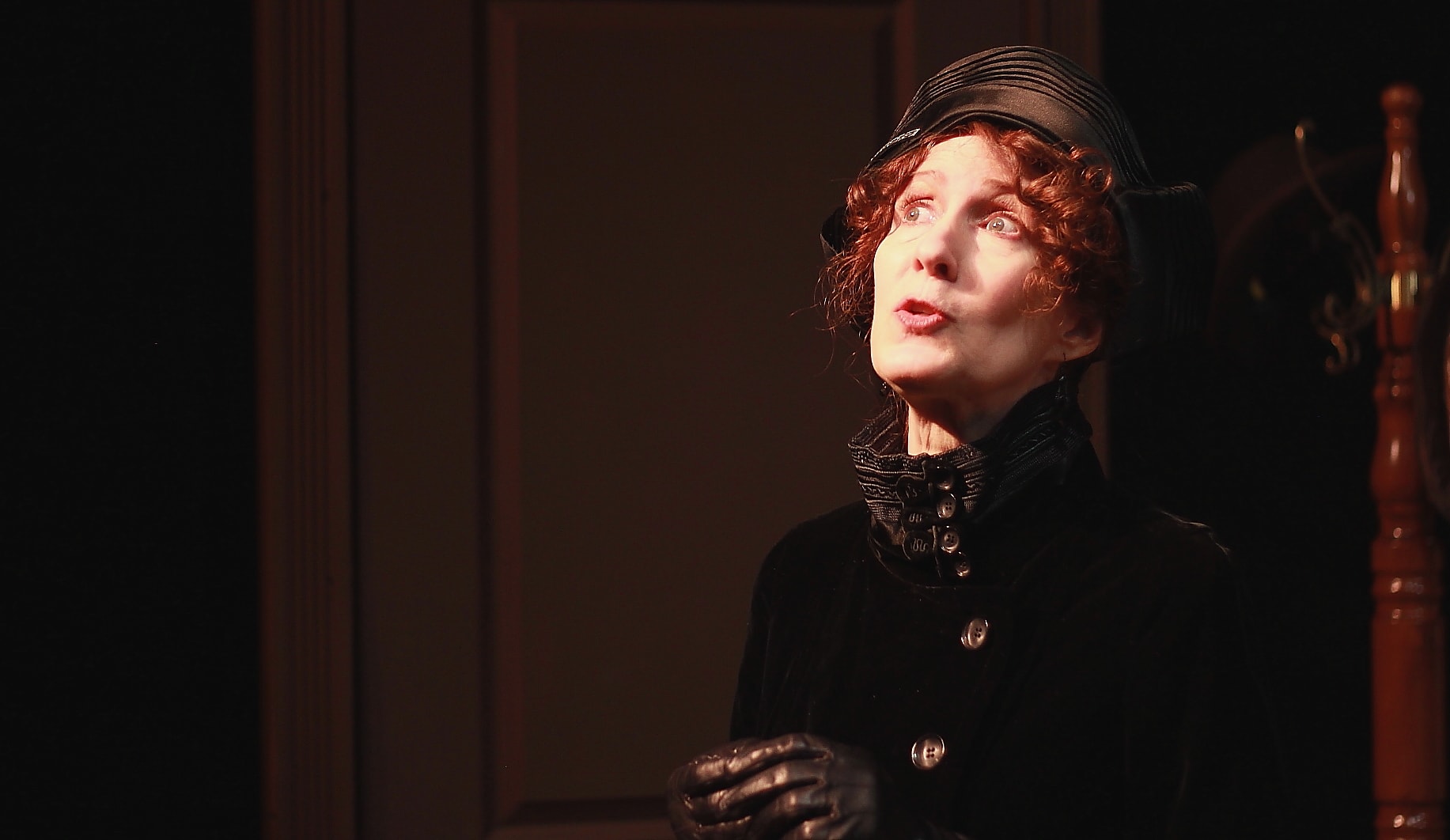There is a mystery at the heart of Ghost-Writer, currently being presented by the Quotidian Theatre Company at The Writer’s Center in Bethesda. Not that Michael Hollinger’s drama is a lighthearted whodunit or a murder mystery that is resolved at the play’s end. The puzzle at the heart of this work is a very serious enigma, a conundrum that will perplex viewers throughout the show and perhaps even afterward.

There are only three characters in Ghost-Writer, which takes place in New York in 1919. First, Franklin Woolsey (Steve LaRocque), a well-known popular novelist. He employs typists to take dictation, feeding them rapid-fire the lines of his novels, including punctuation.
The second character is Woolsey’s mistrusting wife, Vivian (Stephanie Mumford), who has for some time suspected Woolsey of having an affair with whatever secretary is in place. Her primary role in the play involves popping into Woolsey’s office to make sure he is behaving himself. As a couple, Mr. and Mrs. Woolsey seem to have nothing in common.
The third character is Woolsey’s current secretary, Myra (Carol Spring), who at the beginning of the play seems rather passive, quiet, something of a riddle herself. She is apparently an excellent typist, very accurate, and very fast. Gradually, as more and more of the play is narrated by Myra speaking directly to the audience, she takes on more personality and flair. When Woolsey dies suddenly, Myra tells the audience, he just stopped speaking, mid-sentence.
Of course, after Woolsey’s untimely death, the question on everyone’s lips is: what will happen to the book? Will it be published as an unfinished work? The answer is in Myra’s response to his loss: she keeps typing. She is criticized by the press and Woolsey’s wife, who accuses her of wanting to steal the renown of a great writer and pass it off as her own.
We all know about famous authors’ ghostwriters. But there may have been a personal connection between this employer and employee. Woolsey and Myra may have been soul mates. He did allow her to make decisions about the delicate issue of punctuation, after all.

Myra, for her part, insists to an unseen representative of Woolsey’s publisher, that in continuing Woolsey’s work she is not dealing with any kind of beyond-the-grave forgery. She acts as though there is nothing odd about her continuing to “take dictation” without the original author being on hand. It’s as though she’s just filling in, she says. In fact, she says, as writers often say of their sometimes automatic work, “All I know is, the words keep coming.”
Laura Giannarelli directs this period piece smoothly, making it a very enjoyable 90-minute brain teaser. However, Giannarelli makes two curious directorial choices. She has LaRocque play Woolsey in flashback scenes as a rather quiet man whose life has passed him by. He might come across more convincingly if played with more vigor. In the few scenes where Mumford’s Vivian appears, swooping in as if to catch her husband doing something untoward, she also might be better portrayed as a more energetic, overbearing type. Instead, she seems almost shy whenever she arrives unannounced at the office.
It is Spring’s calm at the heart of the storm that holds Ghost-Writer together. While the press and outside observers try to figure out what is going on with the typist, Myra just keeps going, as any assistant would, when his or her boss is incapacitated. Spring’s smooth energy – even in the face of the furious wife – makes her a fascinating, unconventional central character.
John Decker’s set design is a quintessential early twentieth-century writer’s office. The typist’s desk and black manual typewriter sit slightly left of center stage. There is a lot of dark wood around the office windows against the back of the stage. A tea table sits stage right.
Lighting Designer Dan Slater creates some moody atmospheres with light, making it pulsate, enhancing the sense that Myra is talking about the past. Choreographer Vanessa Bisbee is particularly useful at the end of the play when Myra and Woolsey do the foxtrot, flawlessly.
In addition to playing the character of Vivian, Mumford created the costumes for Ghost-Writer. The women’s clothes are quite lovely. Myra wears a long brown skirt, lace-edged blouse, and brown vest. Vivian’s clothes are gorgeous, including an exquisite two-piece white linen suit embroidered with pastel designs and a black, floor-length mourning outfit worn after Woolsey’s death.
Ghost-Writer is something of a departure for the Quotidian Theatre Company, which prides itself on doing naturalistic plays about the beauty of “quotidian” or everyday life. At the core of this comedy/drama remain several curious riddles, none of which are of the everyday sort – how writers write, how people are drawn to one another, how love dissipates. Nevertheless, Ghost-Writer is a haunting play, compellingly told by Quotidian.
Running Time: 90 minutes with no intermission.
Ghost-Writer plays through April 28, 2019, presented by Quotidian Theatre Company at The Writer’s Center, 4508 Walsh St, Bethesda, MD. For tickets, call 301-816-1023 or go online.




